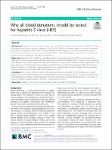Why all blood donations should be tested for hepatitis E virus (HEV)
Denner, Joachim
Pischke, Sven
Steinmann, Eike
Blümel, Johannes
Glebe, Dieter
Background
Hepatitis E is a liver disease caused by a small RNA virus known as hepatitis E virus (HEV). Four major genotypes infect humans, of which genotype 1 and 2 (HEV-1, HEV-2) are endemic mainly in Asia and responsible for waterborne epidemics. HEV-3 and HEV-4 are widely distributed in pigs and can be transmitted to humans mainly by undercooked meat, and contact with pigs. HEV-3 is the main genotype in industrialised countries with moderate climate conditions and object of this debate.
Main text
Whereas an HEV-3 infection in healthy humans is mostly asymptomatic, HEV-3 can induce chronic infection in immunocompromised individuals and acute-on-chronic liver failure (ACLF) in patients with underlying liver diseases. The number of reported cases of HEV-infections in industrialised nations increased significantly in the last years. Since HEV-3 has been transmitted by blood transfusion to other humans, testing of blood donors has been introduced or introduction is being discussed in some industrialised countries. In this article we summarise the arguments in favour of testing all blood donations for HEV-3.
Conclusion
The number of HEV infection in the population and the possibility of HEV transmission by blood transfusion are increasing. Transmission by blood transfusion can be dangerous for the recipients considering their immunosuppressive status, underlying disease or other circumstances requiring blood transfusion. This argues in favour of testing all blood donations for HEV-3 to prevent transmission.
Files in this item

